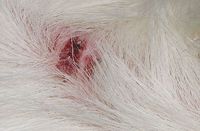Difference between revisions of "Trixacarus"
| (6 intermediate revisions by one other user not shown) | |||
| Line 1: | Line 1: | ||
| − | {{ | + | {{review}} |
| + | |||
{{Taxobox | {{Taxobox | ||
|name = ''Trixacarus'' | |name = ''Trixacarus'' | ||
| Line 8: | Line 9: | ||
|genus = Trixacarus | |genus = Trixacarus | ||
}} | }} | ||
| + | [[Image:trixacarus.jpg|thumb|right|200px|''Trixacarus infestation in a guinea pig.'' - Uwe Gille 2008,Wikimedia Commons]] | ||
Also known as: '''''Selnick mite | Also known as: '''''Selnick mite | ||
==Introduction== | ==Introduction== | ||
| − | + | ||
''Trixacarus'' mites are [[Burrowing Mites|burrowing mites]] of rodents. They cause Trixacaral mange, particularly in guinea pigs. | ''Trixacarus'' mites are [[Burrowing Mites|burrowing mites]] of rodents. They cause Trixacaral mange, particularly in guinea pigs. | ||
| Line 32: | Line 34: | ||
==Important Species== | ==Important Species== | ||
| − | ''Trixacarus caviae'' - This species causes | + | ''Trixacarus caviae''- This species causes mange in guinea pigs. |
| + | |||
| + | ''Trixacarus diversus''- This species causes mange in rats, mice and hamsters. | ||
| + | |||
| + | ==Test yourself with the Mites Flashcards== | ||
| + | |||
| + | [[Mites_Flashcards|Mites Flashcards]] | ||
| + | |||
| + | ==Literature Search== | ||
| + | [[File:CABI logo.jpg|left|90px]] | ||
| − | |||
| − | + | Use these links to find recent scientific publications via CAB Abstracts (log in required unless accessing from a subscribing organisation). | |
| − | + | <br><br><br> | |
| − | + | [http://www.cabdirect.org/search.html?q=title:(%22Trixacarus%22)+ ''Trixacarus'' publications] | |
| − | |||
| − | |||
==References== | ==References== | ||
| Line 48: | Line 56: | ||
| − | + | ||
| + | |||
| + | |||
| + | |||
[[Category:Burrowing_Mites]] | [[Category:Burrowing_Mites]] | ||
| + | |||
| + | [[Category:To_Do_-_AimeeHicks]] | ||
| + | [[Category:Expert_Review]] | ||
Revision as of 21:54, 5 October 2010
| This article has been peer reviewed but is awaiting expert review. If you would like to help with this, please see more information about expert reviewing. |
| Trixacarus | |
|---|---|
| Phylum | Arthropoda |
| Class | Arachnida |
| Order | Astigmata |
| Family | Sarcoptidae |
| Genus | Trixacarus |
Also known as: Selnick mite
Introduction
Trixacarus mites are burrowing mites of rodents. They cause Trixacaral mange, particularly in guinea pigs.
Identification
The mites are similar to Sarcoptes mites, but half the size. The mites can be identified from Notoedres mites by their prominent sharp dorsal spines.
Life cycle
Trixacarus mites have a 3 week life cycle and can only survive a few weeks off the host. They are species specific and can be transmitted through direct contact, particularly through close contact between mother and offspring.
Infection
The mites cause severe pruritus in laboratory rodents and guinea pigs. Their burrowing activity causes biting, scratching and irritation. This leads to to inflammation, pruritus and alopecia. Affected areas show acanthosis and hyperkeratosis. Death can occur within 3-4 months of infection if it is not treated.
Diagnosis
Mite infection can be diagnosed by clinical signs and a skin scrape of a 'non-scratched' region.
Important Species
Trixacarus caviae- This species causes mange in guinea pigs.
Trixacarus diversus- This species causes mange in rats, mice and hamsters.
Test yourself with the Mites Flashcards
Literature Search
Use these links to find recent scientific publications via CAB Abstracts (log in required unless accessing from a subscribing organisation).
Trixacarus publications
References
Kummel BA, Estes SA, Arlian LG. (1980) Trixacarus caviae infestation of guinea pigs. J Am Vet Med Assoc. 1;177(9):903–908.

